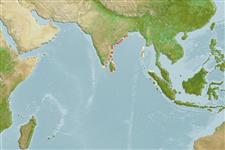Classification / Names
Noms communs | Synonymes | Catalog of Fishes(Genre, Espèce) | ITIS | CoL | WoRMS | Cloffa
Issue
This species has no status in Eschmeyer (CofF ver. Jul. 2010: Ref. 84883). Please send references, or more studies are needed.
Environment: milieu / climate zone / profondeur / distribution range
Écologie
marin bathydémersal; profondeur 439 - 505 m (Ref. 58018). Tropical
Indian Ocean: India.
Taille / Poids / Âge
Maturité: Lm ? range ? - ? cm
Life cycle and mating behavior
Maturité | Reproduction | Frai | Œufs | Fécondité | Larves
Kapoor, D., R. Dayal and A.G. Ponniah, 2002. Fish biodiversity of India. National Bureau of Fish Genetic Resources Lucknow, India.775 p. (Ref. 45255)
Statut dans la liste rouge de l'IUCN (Ref. 130435: Version 2025-1)
Menace pour l'homme
Harmless
Utilisations par l'homme
Outils
Articles particuliers
Télécharger en XML
Sources Internet
Estimates based on models
Preferred temperature (Réf.
123201): 4.7 - 6, mean 5.4 °C (based on 29 cells).
Phylogenetic diversity index (Réf.
82804): PD
50 = 0.5078 [Uniqueness, from 0.5 = low to 2.0 = high].
Bayesian length-weight: a=0.01000 (0.00244 - 0.04107), b=3.04 (2.81 - 3.27), in cm total length, based on all LWR estimates for this body shape (Ref.
93245).
Niveau trophique (Réf.
69278): 4.1 ±0.8 se; based on size and trophs of closest relatives
Résilience (Réf.
120179): Milieu, temps minimum de doublement de population : 1,4 à 4,4 années (Preliminary K or Fecundity.).
Fishing Vulnerability (Ref.
59153): Moderate vulnerability (43 of 100).
🛈
